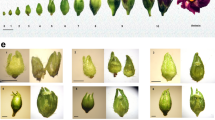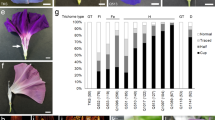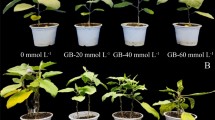Abstract
IN a previous communication1 I reported that emasculation of Glechoma hederacea flower buds resulted in a reduction in corolla size similar to that found in naturally occurring female flowers, and I suggested that the anthers produced a hormone causing enlargement of the corolla. An attempt to replace this by the application of β-indolylacetic acid to emasculated buds was ineffective—low concentrations having no effect and high concentrations (500 and 1,000 p.p.m.) causing inhibition of corolla growth.
Similar content being viewed by others
Article PDF
References
Plack, A., Nature, 180, 1218 (1957).
Khoo, U., and Stinson, H. T., Proc. U.S. Nat. Acad. Sci., 43, 603 (1957).
Brian, P. W., and Hemming, H. G., Physiol. Plantarum, 8, 669 (1955).
Author information
Authors and Affiliations
Rights and permissions
About this article
Cite this article
PLACK, A. Effect of Gibberellic Acid on Corolla Size. Nature 182, 610 (1958). https://doi.org/10.1038/182610a0
Issue date:
DOI: https://doi.org/10.1038/182610a0
This article is cited by
-
Intra- and Inter-Plant Level Correlations among Floral Traits in Iris Gracilipes (Iridaceae)
Evolutionary Ecology (2005)
-
Effect of gibberellic acid on carnation flower senescence: evidence that the delay of carnation flower senescence by gibberellic acid depends on the stage of flower development
Plant Growth Regulation (1992)
-
Optimal pollination conditions for seed set after a self-pollination, an intraspecific cross and an interspecific cross of marrow-stem kale (Brassica oleracea var. acephala)
Euphytica (1990)
-
Growth of anthers in Lilium longiflorum
Planta (1988)
-
Gynodioecy inSaxifraga granulata L. (Saxifragaceae)
Plant Systematics and Evolution (1985)



